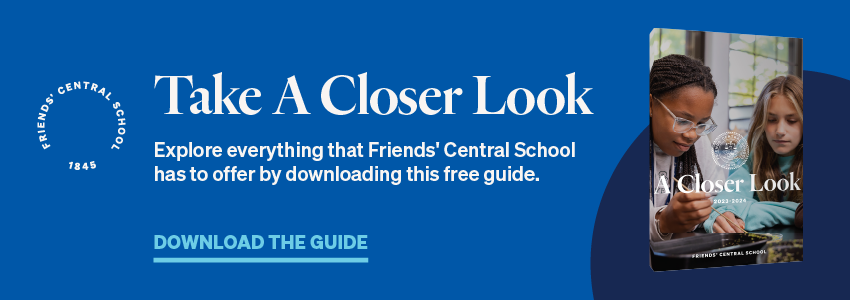
News about the coronavirus is everywhere. It’s on the radio. It’s in the news. It’s online, in television shows, and in emails. It’s everywhere, for all of us—including our children.
Even the youngest of children have by now likely noticed a change in their daily or weekly routines, prompting questions like: Why can’t I see my friends? Why can’t I go to school? Why don’t you have to go in to work anymore?
Free Downloadable Guide: Take a Closer Look at Friends' Central School
It is natural for parents to want to protect their children from undue stress and fear. And, it is appropriate to shield your children from the TV and radio news, but, the simple fact is, we can’t hide the truth from our children. Sharing appropriate information is part of keeping them safe. Given that, it’s important that parents recognize that they can and should talk to their children about the coronavirus—in order to answer their questions, assuage any stress or worry, and learn from the situation in order to stay safe.
Are you unsure of exactly how you should bring up the subject of coronavirus with your child? Below are some tips that can help you frame the discussion in a positive, constructive way.
How to Talk to Your Kids About COVID-19
1. Be honest, but age-appropriate.
In the classroom, great teachers begin a lesson by asking the students what they already know about a subject. The same approach should apply when parents begin talking to their children about COVID-19.
By asking your children what they already know, you’re able to frame your discussion around the facts that they already have. This gives you an opportunity to fill in the blanks and enough details, without overloading your children with too much information at once. You may also be surprised by not only your children’s questions and concerns, but also how much information they already know about the current situation.
It’s also important to keep the information age-appropriate.
Elementary-aged children need brief, simple explanations and regular assurances that adults are working to keep them healthy and take care of people who are sick. Children in middle school need similar reassurances, but may be more vocal with their questions. Furthermore, children at this age may need more help separating the reality of the situation from simple rumors they come across online or through social media.
Parents of high-school students are in a little bit of a different situation. High school students are able to discuss the issue more in-depth and can benefit from reading appropriate sources about COVID-19 directly. However, this also means they are more likely to be exposed to incorrect or vague information about the virus on, which can lead to increased stress and confusion. As a result, it is your job to be there to help them find accurate information while also encouraging them to scale back how often they check their phones for updates.
Acknowledging your child’s concerns will not increase his or her anxiousness. If anything, it will teach him or her how to cope with stressful situations. It is possible to be honest, clear, and thoughtful while also being mindful of your child’s age.
Furthermore, it is also sometimes necessary to prevent him or her from imagining situations that are far worse than the reality. Seeing people walking around in public wearing masks may be scary for some, but you can explain that wearing masks holds sneezes and coughs from getting into the air, helping to keep everyone safe.
2. Use reliable sources.
Do your research ahead of time. Consuming reliable information and reporting from distinguished experts and journalists who are engaged in highly factual reporting about COVID-19 is important, but do not constantly watch for updates. This will only increase the sense of worry.
Finding reliable information helps assuage the heightened tension caused by “what if” scenarios. Objective statistics around COVID-19 are the best remedy to fear-inducing rumors that kids may read on the internet or social media.
Organizations such as the CDC and research universities are good clearing houses of information. In addition, the WHO also manages a link dedicated to busting myths revolving around the coronavirus.
3. Be available and empathetic.
If you build it—they will come. Establish a space where you are available to talk every day and your children will feel comfortable coming to you to ask questions and share concerns. Empathize with their fear or grief, but talk to other adults about yours as well. Our children are different from our friends and don’t need to be burdened by our baggage.
4. Emphasize self care.
In addition to talking to your child about COVID-19, it is also important to keep practicing healthy behaviors like social distancing. Stressing these will show your children they can play a role in minimizing the disease’s spread, giving them a sense of control over their situation.
Keep a regular schedule. Set time for kids to do schoolwork and exercise, and emphasize the importance of healthy sleep habits and limited screen time. This will also limit their exposure to any false information that may be on the internet or social media. Committing to these practices on a daily basis increases our and our children’s agency which helps us show we are contributing to our community—locally and globally.
5. Model a healthy response.
It’s normal to be stressed or anxious due to the tension of the current situation. So, before approaching your child, check your headspace. Make sure you are in the right mindset to emit reassurance. Kids are able to pick up on both verbal and nonverbal signals. They’ll know if you are saying one thing but feeling another.
Once you are prepared mentally and emotionally, reassure your kids by modeling healthy habits. Many of these behaviors are good habits to practice anyway such as coughing or sneezing into your elbow, washing hands regularly, not sharing food or drinks, and using hand sanitizer if soap and water are unavailable. Doing this will let them know you are taking precautions to stay safe and will teach them the skills they need to continue to be safe.
6. Get help if you need it.
Unless you work in the medical field, your child may have questions that you are simply unable to answer. If this happens, encourage him or her to talk to their school-based clinicians. Even if schools may be closed, we are all still an email away from creating a safe, confidential forum to explore feelings and thoughts. Remind them that the adults in their life are there to keep them safe.
The Big Picture
This is an uncertain time for everyone. However, it is possible for children to continue living their lives as normally as possible while also being aware of what is happening.
Continue to practice healthy habits like you and your family normally would. Get enough sleep, wash your hands, and eat a balanced diet. Modeling a calm response will ensure we get through this uncertain challenge and are stronger once it passes.



